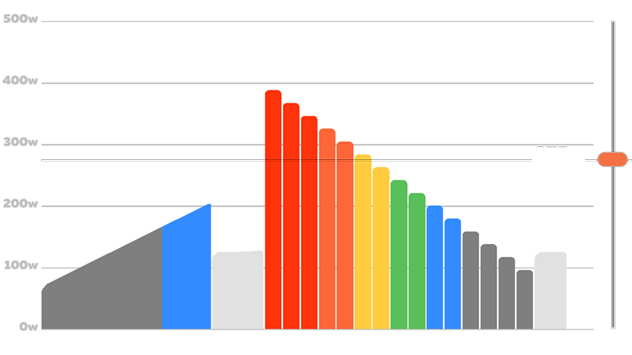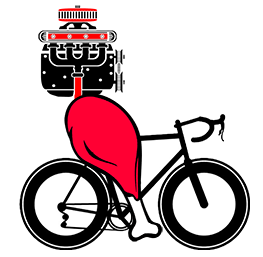The well-known ramp test or ramp workout is frequently used by endurance athletes either to measure progress (test) or elicit progress (training session) or both. The athlete increase power (cycling, rowing erg) etc. or pace (running) every certain amount of time (1 min blocks, 3 minute blocks, 5 minute blocks etc.)

But what about a reversed protocol, where athletes start at an estimated level of ability and then step down each block? Does this workout protocol have the ability to increase VO2 max? One study says yes, and another says no. Note: Study 1 is done with cyclists and Study 2 with runners and rowers. Despite this, we’d likely expect to find similar outcomes. They weren’t.
Want to run your own N=1 test? Grab the Reverse Ramp Test Workout File Here for Zwift.
Study 1: Yes, Reverse Ramp Tests and Workouts Improve VO2 max better than Increasing Ramp Tests
A recent study examined whether cyclists can improve their maximal oxygen consumption (VO2 max) using a novel decremental exercise protocol versus a traditional incremental protocol. VO2 max is the maximum amount of oxygen an athlete can use during intense exercise and is a key measure of endurance.
The study tested 26 subjects using incremental (INC) and decremental (DEC) cycling tests on separate days. The increasing (ramp test) protocol increased intensity until exhaustion to measure VO2 max. The decreasing (reverse ramp test) protocol began at the same intensity as the highest increasing ramp stage but then decreased intensity over time.
Surprisingly, cyclists achieved a 4.4% higher VO2 max using the decreasing versus increasing protocol. The researchers theorized that VO2 max plateaus during normal INC tests do not actually represent the cardiovascular system’s maximal oxygen transport capacity.
However, it is unclear if DEC protocols provide additional benefits for highly trained cyclists or improve performance. The study only measured VO2 max and did not evaluate exercise performance. The underlying mechanisms enabling a higher VO2 max during DEC also remain unknown.
Additional research is needed to determine if DEC protocols enhance endurance in competitive cyclists. However, based on current evidence, cyclists should continue to rely on traditional INC testing and high-intensity interval training, which have proven benefits for improving VO2 max and performance. DEC protocols represent an experimental technique with unproven effects on racing ability.
Study 2: No, Reverse Ramp Protocols Do NOT Improve VO2 max Better Than Incrementally Increased Stepped Ramp Tests.
A recent study evaluated and compared the maximum amount of oxygen an athlete can utilize during exercise (VO2 max) using incremental and decremental testing protocols. Nineteen well-trained runners and rowers completed multiple VO2 max tests on separate days using different protocols. The goal was to determine if decremental tests, where exercise intensity decreases, allow athletes to achieve a higher VO2 max than traditional incremental tests, where intensity increases progressively.
The incremental test (INC) involved running on a treadmill with increasing speed and incline up to exhaustion. VO2 max during the INC test averaged 61.3 ml/kg/min. The decremental test (DEC) proceeded from a high intensity down to lower levels, but resulted in a nearly identical VO2 max of 61.1 ml/kg/min, only around 11.58 ml/min higher (not statistically significant). Tests combining incremental and decremental phases (DEC-INC) or repeating the incremental test (INCF) also did not result in higher VO2 max values. VO2 max during a follow-up verification phase (VER) was slightly lower (59.8 ml/kg/min, around 2.45% decrease).
In summary, despite some expectations to the contrary, decremental testing protocols do not appear to produce higher VO2 max results than traditional incremental tests in well-trained endurance athletes. The maximum amount of oxygen an athlete can utilize during intense exercise seems to remain stable regardless of changes in intensity during a test. For endurance athletes, this means that a leveling off of oxygen uptake during incremental testing likely does represent a true physiological maximum, rather than a premature termination of the test. Athletes should continue to rely on traditional incremental VO2 max testing to determine aerobic capacity and set appropriate training intensities. While decremental testing may have other uses, maximizing VO2 max does not appear to be one of them based on the current study. Unless and until further research proves otherwise, endurance athletes can trust that their VO 2max plateaus represent their true aerobic potential.
In summary, the study found no difference in VO2 max between incremental and decremental testing in trained athletes. A conclusion for endurance athletes is that traditional incremental tests continue to be the gold standard for determining VO2 max and aerobic capacity. Unless future research shows otherwise, athletes can rely on VO2 max plateaus during incremental tests as representing their maximum physiological limit.
A Future Study Idea from Meat Motor
It would be interesting to see if a reverse test, which starts slightly above the final step of the increasing test, is completable by the athlete and what responses that test elicits. For example, in a 1-minute incremental stepped ramp test, in the final minute before failure, an athlete is able to generate 400 watts. Create a study in which, in a decreasing ramp test, the athlete’s first minute starts at 410 watts (or 420 watts, etc.). He or she should be able to sustain this because the preceding time block would not have been accumulated in terms of fatigue.
Abstract for Study 1
Conventional testing methods produce submaximal values of maximum oxygen consumption
Background: This study used a novel protocol to test the hypothesis that a plateau in oxygen consumption (VO(2 max)) during incremental exercise testing to exhaustion represents the maximal capacity of the cardiovascular system to transport oxygen.
Methods: Twenty-six subjects were randomly divided into two groups matched by their initial VO(2 max). On separate days, the reverse group performed (i) an incremental uphill running test on a treadmill (INC(1)) plus verification test (VER) at a constant workload 1 km h(-1) higher than the last completed stage in INC(1); (ii) a decremental test (DEC) in which speed started as same as the VER but was reduced progressively and (iii) a final incremental test (INC(F)). The control group performed only INC on the same days that the reverse group was tested.
Results: VO(2 max) remained within 0.6 ml kg(-1) min(-1) across the three trials for the control group (p=0.93) but was 4.4% higher during DEC compared with INC(1) (63.9 ± 3.8 vs 61.2 ± 4.8 ml kg(-1) min(-1), respectively, p=0.004) in the reverse group, even though speed at VO(2 max) was lower (14.3 ± 1.1 vs 16.2 ± 0.7 km h(-1) for DEC and INC(1), respectively, p=0.0001). VO(2 max) remained significantly higher during INC(F) (63.6 ± 3.68 ml kg(-1) min(-1), p=0.01), despite an unchanged exercise time between INC(1) and INC(F).
Conclusion: These findings go against the concept that a plateau in oxygen consumption measured during the classically described INC and VER represents a systemic limitation to oxygen use. The reasons for a higher VO(2) during INC(F) following the DEC test are unclear.
Fernando G Beltrami, Christian Froyd, Alexis R Mauger, Alan J Metcalfe, Frank Marino, Timothy D Noakes
British Journal of Sports Medicine 2012 Jan;46(1):23-9. doi: 10.1136/bjsports-2011-090306.
Abstract for Study 2
Incremental and decremental cardiopulmonary exercise testing protocols produce similar maximum oxygen uptake in athletes
The aim of the study was to evaluate and compare the maximal oxygen uptake ([Formula: see text]O2max) achieved during incremental and decremental protocols in highly trained athletes. Nineteen moderate trained runners and rowers completed, on separate days, (i) an initial incremental [Formula: see text]O2max test (INC) on a treadmill, followed by a verification phase (VER); (ii) a familiarization of a decremental test (DEC); (iii) a tailored DEC; (iv) a test with decremental and incremental phases (DEC-INC); (v) and a repeated incremental test (INCF). During each test [Formula: see text]O2, carbon dioxide production, ventilation, heart and breath rates and ratings of perceived exertion were measured. No differences were observed in [Formula: see text]O2max between INC (61.3 ± 5.2 ml kg-1 min-1) and DEC (61.1 ± 5.1 ml kg-1 min-1; average difference of ~ 11.58 ml min-1; p = 0.831), between INC and DEC-INC (60.9 ± 5.3 ml kg-1 min-1; average difference of ~ 4.8 ml min-1; p = 0.942) or between INC and INCF (60.7 ± 4.4 ml kg-1 min-1; p = 0.394). [Formula: see text]O2max during VER (59.8 ± 5.1 ml kg-1 min-1) was 1.50 ± 2.20 ml kg-1 min-1 lower (~ 2.45%; p = 0.008) compared with values measured during INC. The typical error in the test-to-test changes for evaluating [Formula: see text]O2max over the five tests was 2.4 ml kg-1 min-1 (95% CI 1.4-3.4 ml kg-1 min-1). Decremental tests do not elicit higher [Formula: see text]O2max than incremental tests in trained runners and rowers, suggesting that a plateau in [Formula: see text]O2 during the classic incremental and verification tests represents the maximum ceiling of aerobic power.
Nuno Manuel Frade de Sousa, Danilo Rodrigues Bertucci, Gabriel Medeiros de Sant’Ana, Pedro Luiz Ribeiro Angelucci Padua, Diogo Mello da Rosa
Scientific Report 2021 Jun 23;11(1):13118. doi: 10.1038/s41598-021-92191-2.
Listen to the Two Minute Summary

Jordan Fowler has experience as a head swimming coach of the Frisco Swim Team, a TAAF-awarded coach, a track and field distance running consultant for select Texas High School runners, and has competed as a triathlete, road runner, and cyclist. Though he is remarkably slower than he was in his 20s and 30s, he still enjoys endurance sports and sports science studies.
